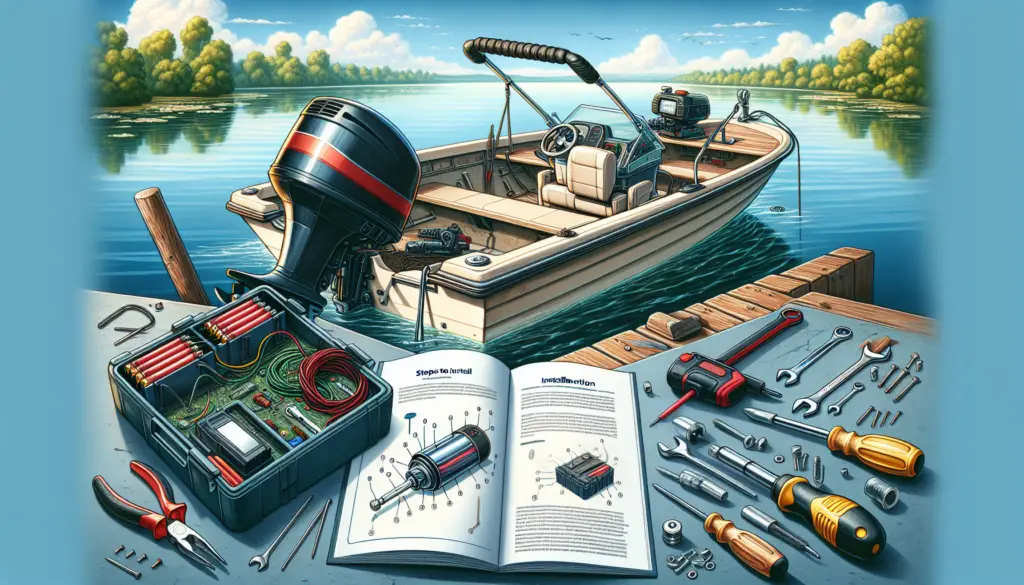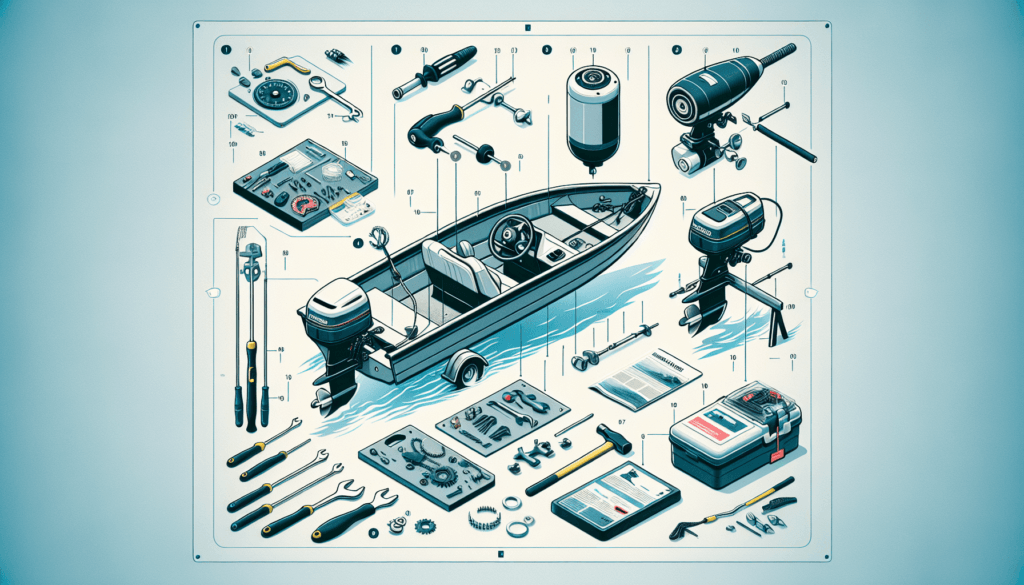So, you’ve finally made the decision to install a trolling motor on your boat, but you’re not quite sure where to start. Don’t worry, because we’ve got you covered. In this article, we will provide you with a step-by-step guide on how to successfully install a trolling motor on your boat, ensuring a smooth and hassle-free process. Whether you’re a fishing enthusiast or simply looking to enhance your boating experience, this article will equip you with the knowledge and confidence to embark on this exciting DIY project. Let’s get started!

Tools and Materials Needed
To successfully install a trolling motor on your boat, you will need the following tools and materials:
- Wrench or socket set
- Drill and drill bits
- Screwdriver
- Wire cutters
- Wire stripper
- Marine sealant
- Measuring tape
- Battery cables
- Trolling motor mount
- Trolling motor
Having these tools and materials ready will make the installation process much smoother and more efficient.
Choosing the Right Trolling Motor
Before you start installing a trolling motor on your boat, it’s essential to choose the right one that suits your needs. Consider the following factors when selecting a trolling motor:
1. Consider the boat size and weight:
The size and weight of your boat are crucial factors in determining the appropriate trolling motor. A larger boat will require a more powerful motor to achieve optimum performance. Be sure to check the manufacturer’s recommendations for the maximum boat size the trolling motor can handle.
2. Decide on the motor shaft length:
The shaft length of the trolling motor is determined by the distance between the motor’s mounting surface and the waterline. Measure this distance carefully before making your purchase. If the shaft is too short, the propeller may not efficiently propel the boat. If it’s too long, it can cause unnecessary drag and potential damage to the motor.
3. Determine the desired thrust power:
Thrust power refers to the strength of the trolling motor’s propeller. It’s essential to match the motor’s power with your boat’s weight and the conditions in which you’ll be using it. The higher the thrust power, the more control and maneuverability you’ll have on the water.
4. Choose between bow or transom mount:
Bow-mounted motors provide better control and maneuverability, especially in windy conditions. Transom-mounted motors are easier to install and are better suited for smaller boats or those with limited space on the bow. Consider your boat’s design and your preferred style of boating before making a decision.
5. Consider the control options:
Trolling motors can be controlled manually, by foot pedal, or through a remote control. Each option has its advantages, so think about which one will be most convenient and comfortable for you to use while on the water.
By taking these factors into account, you can ensure that you choose the ideal trolling motor for your boat.
Preparing the Boat
Now that you have selected the right trolling motor for your boat, it’s time to prepare the boat for installation. Follow these steps to get your boat ready:
1. Determine the suitable location for the motor:
Before starting the installation, carefully choose the location where you want to mount the trolling motor. Consider the balance and weight distribution of your boat to ensure optimal performance.
2. Clean and dry the mounting area:
Thoroughly clean the mounting area on your boat’s stern or bow, depending on the type of motor mount you have chosen. Remove any debris, dirt, or old adhesive that may interfere with a secure installation. Dry the area completely to ensure proper adhesion of the mounting bracket.
3. Measure and mark the hole positions:
Using a measuring tape, measure and mark the hole positions for the mounting bracket. Take your time to ensure accuracy, as the alignment of the bracket is crucial for a stable and secure installation.
4. Check the stern or bow thickness:
By measuring the thickness of the stern or bow, you can determine the appropriate size of the mounting hardware needed. It’s important to use hardware that matches the thickness of your boat to ensure a secure and stable installation.
5. Ensure the mounting surface is sturdy:
Inspect the mounting surface to make sure it is sturdy and free from any damage or deterioration. If you notice any weak areas, reinforce them before proceeding with the installation.
By properly preparing your boat, you can ensure a smooth and secure installation of the trolling motor.
Installing the Mounting Bracket
Once your boat is prepared, it’s time to install the mounting bracket. Follow these steps to get the bracket securely in place:
1. Attach the mounting bracket to the boat:
Position the mounting bracket over the marked holes and attach it to the boat using the appropriate screws or bolts. Make sure the bracket is aligned properly with the marking to ensure a level and stable installation.
2. Secure the mounting bolts tightly:
Using a wrench or socket set, tighten the mounting bolts securely. Be careful not to over-tighten, as this could damage the boat’s structure. Double-check the stability of the bracket by gently shaking it.
3. Apply a marine sealant for extra protection:
To provide additional protection against water intrusion, apply a marine sealant around the edges of the mounting bracket. This will help prevent leaks and ensure a watertight seal.
4. Check the stability and alignment:
Once the sealant has dried, check the stability and alignment of the mounting bracket. Ensure that it is securely fastened and level. Any instability or misalignment should be corrected before proceeding with the next steps.
By following these steps, you can securely install the mounting bracket for your trolling motor.

Wiring the Trolling Motor
Proper wiring is crucial for the efficient functioning of your trolling motor. Follow these steps to wire the motor correctly:
1. Attach the battery cables to the trolling motor:
Connect the appropriate battery cables to the trolling motor, ensuring that the positive and negative terminals are correctly aligned. Refer to the manufacturer’s instructions for the correct connections.
2. Choose the appropriate wire gauge:
Select the appropriate wire gauge to ensure that it can handle the electrical load of the trolling motor. Using wire cutters, cut the wire to the desired length, leaving a bit of extra length for flexibility and ease of installation.
3. Connect the positive and negative wires:
Using a wire stripper, strip the insulation from the positive and negative wires, revealing the bare copper. Connect the positive wire to the positive terminal on the motor and the negative wire to the negative terminal, ensuring a secure connection.
4. Secure the connections with heat shrink tubing:
To protect the connections from moisture and corrosion, slide heat shrink tubing over each wire connection. Heat the tubing evenly with a heat gun until it shrinks tightly around the connection, creating a watertight seal.
5. Route the wires neatly and safely:
Carefully route the wires along your boat, securing them with zip ties or clips to prevent them from getting tangled or damaged. Ensure that the wires are safely tucked away to avoid any trip hazards or interference with other boat components.
By following these steps, you can ensure a safe and proper wiring installation for your trolling motor.
Connecting the Trolling Motor
With the wiring complete, it’s time to connect the trolling motor to the mounting bracket. Follow these steps for a secure connection:
1. Slide the trolling motor onto the mounting bracket:
Carefully slide the trolling motor onto the mounting bracket, aligning the motor shaft with the mounting hole.
2. Align the motor shaft with the mounting hole:
Ensure that the motor shaft is correctly aligned with the pre-drilled mounting hole. This will allow for a smooth and secure connection.
3. Securely tighten the mounting bolts:
Using a wrench or socket set, tighten the mounting bolts securely to hold the trolling motor in place. Double-check the tightness to ensure that the motor is firmly attached.
4. Check the motor alignment:
With the trolling motor connected, check its alignment with the boat. Make any necessary adjustments to ensure that the motor is straight and in the desired position. Proper alignment will ensure optimal performance and maneuverability.
Following these steps will ensure a proper and secure connection between the trolling motor and the mounting bracket.

Testing the Trolling Motor
Before heading out on the water, it’s crucial to test the trolling motor to ensure that it is functioning correctly. Follow these steps to conduct a thorough test:
1. Connect the battery to the motor:
Connect the fully charged battery to the trolling motor, ensuring that the positive and negative terminals are correctly aligned.
2. Turn on the motor and check functionality:
Turn on the trolling motor and check that it runs smoothly. Test the various speed settings and make sure that the motor responds accordingly.
3. Ensure proper steering and control:
Test the steering mechanism to ensure that it moves freely and responds accurately to your commands. Ensure that you have full control over the direction and speed of the motor.
4. Make any necessary adjustments or repairs:
If any issues or abnormalities are detected during testing, make the necessary adjustments or repairs. This may include tightening connections, adjusting the motor alignment, or troubleshooting any electrical or mechanical issues.
By conducting a thorough test, you can identify and address any issues before heading out onto the water, ensuring a safe and enjoyable boating experience.
Tips and Safety Precautions
Installing a trolling motor on your boat can be a rewarding experience. However, it’s important to keep these tips and safety precautions in mind:
1. Read the manufacturer’s instructions carefully:
Before starting the installation process, thoroughly read and understand the manufacturer’s instructions. Following these instructions will ensure proper installation and safe operation.
2. Use appropriate safety gear while installing:
When working with tools and equipment, always wear appropriate safety gear, such as safety glasses and gloves. This will protect you from potential injuries.
3. Regularly inspect and maintain the motor:
To keep your trolling motor in optimal condition, regularly inspect it for any signs of damage or wear. Clean and lubricate the motor as recommended by the manufacturer and address any maintenance or repair needs promptly.
4. Protect the motor from damage and corrosion:
When not in use, protect your trolling motor from damage by covering it or storing it in a dry and secure location. Apply marine grease or anti-corrosion spray to exposed metal parts to prevent corrosion.
5. Follow local boating and fishing regulations:
Ensure that you familiarize yourself with and adhere to the boating and fishing regulations specific to your location. This includes any restrictions or guidelines related to the use of trolling motors.
By keeping these tips and safety precautions in mind, you can ensure a safe and successful installation of your trolling motor.

Frequently Asked Questions
As you embark on installing a trolling motor on your boat, you may have some common questions. Here are answers to frequently asked questions:
1. What size trolling motor do I need?
The size of the trolling motor you need depends on the size and weight of your boat. Refer to the manufacturer’s recommendations or consult with an expert to determine the appropriate size for your specific boat.
2. Can I install a trolling motor myself?
Yes, it is possible to install a trolling motor yourself. However, it’s important to have the necessary tools, knowledge, and patience to ensure a proper and secure installation. If you’re unsure or uncomfortable, consider seeking professional assistance.
3. How do I select the right battery for the motor?
To select the right battery for your trolling motor, consider the motor’s power requirements and your desired usage time. Choose a battery with sufficient amp-hour (AH) rating and ensure it is compatible with your motor’s voltage requirements.
4. Can I use a trolling motor in saltwater?
Yes, there are trolling motors specifically designed for saltwater use. These motors have additional corrosion-resistant features to withstand the harsh environment. It’s important to choose a trolling motor specifically labeled for saltwater use if you plan to operate your boat in saltwater.
5. How long does it take to install a trolling motor?
The installation time can vary depending on your experience level, the complexity of your boat’s setup, and the type of trolling motor. On average, it can take a few hours to complete the installation from start to finish. Give yourself ample time and don’t rush through the process to ensure a proper installation.
Conclusion
Congratulations! You have successfully installed a trolling motor on your boat. Before hitting the water, take a moment to review the installed trolling motor, ensuring all connections are secure and tight. Double-check that the motor is aligned properly and that all functionality is working as expected.
With your new trolling motor in place, get ready for an enhanced boating experience. Enjoy the freedom and control it provides on the water, and always remember to follow boating and fishing regulations to ensure a safe and enjoyable time on your boat.


